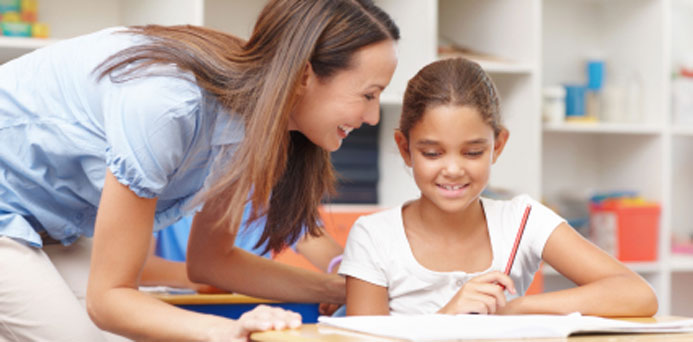The things that are most important to children are mathematical in nature.
Whether making sure everything stays fair among siblings, (“Did I get as much candy as she did?”) or organizing their dolls and action figures, kids are exploring math concepts.
They are also asking questions that require math, such as, “Am I growing? Am I bigger than my brother?” Parents are in a great position to enhance that learning by simply noticing when it happens and guiding their exploration.
Watch for patterns
Stringing beads is a fun art activity for kids but it’s also a great exercise in abstract thinking. Take time to appreciate your child’s designs and you’ll probably notice patterns and symmetry.
She may just think it looks pretty, but you can help her recognize a big mathematical concept if you say, “Look, you made a pattern! I see that the colors red and green repeat over and over.” Or, “See how each half of this necklace is the same? That’s called symmetry.” It’s also important to get her thinking about how she achieved that design. Ask about how many beads of each color she used. Ask her why she chose the colors and beads that she did and how she knows which bead comes next.
Sort things out
Does your kid like to organize his toys according to good guys and bad guys or sort his cars by color? Take a moment next time to ask him about the “rules” of his sorting. Sometimes the reasoning can be quite complex. Talking is crucial here because labeling his sets requires him to use language that is abstract, logical and generalized. Ask him how many other ways he can sort his toys. Tally up the possibilities and you get a bonus counting lesson too!
Draw a map to mathematical discovery
Need a rainy day activity? Have your child draw a treasure map to lead you to one of her toys. As you read it, make sure she hears the positional and directional words that guide you around the couch, under the dining room table, and up the stairs. This vocabulary is extremely helpful for describing the ways objects relate to one another spatially. Also, look at the whole shape of the path. Does it form any familiar shapes? This could also be a good opportunity to talk about the geometry in her design.
Make bath time math time
Next time he’s taking a bath, give him 2 plastic cups that are different sizes and shapes and see what he does with them. Betcha he starts pouring water from one into another. Ask him which one he thinks holds the most and then think together about how you can find out for sure.
Fair share
There are 5 cookies left and 3 kids. What do you do? You might not believe it but children have an intuitive grasp of fractions long before they’ve even heard of them. If you let them problem solve this on their own, you might be surprised at their egalitarian sensibilities as well as their mathabilities. Similar opportunities arise in competitive situations like when they play “Go Fish,” and have to count to know who has more cards at the end.
Bottom line: when children are motivated to figure something out, skills like counting and comparing become very meaningful to them.
Building big ideas
Does your child like to play with blocks? Next time her tower crumbles, sit down and talk with her as she rebuilds. Ask her which block she wants to add next and, more importantly, why. This is a great opportunity to talk about the qualities of each block: if they’re tall, round, wide, thin, etc. You can also discuss the qualities of the tower as a whole: Should it have a wide or narrow base or how tall can it get and still be stable?
One big caveat: Don’t expect the “right” answers; instead, allow your child to explore new ideas and possibilities and try out different methods—it’s how kids learn best!
Read the math in storybooks
Take time to notice the math that happens throughout the stories you read with your child.
Growing and repeating patterns are a big part of most fairytales. Ask your child what he thinks will happen next after Goldilocks finds the beds that are too hard and too soft. He’ll love being able to predict that the third will be just right. If you’re reading “The Gingerbread Man,” pause to count how many people are after him each time someone new joins or leaves the chase.
We know math is important. We know that a child’s early math skills predict later success in both math and reading. This does not mean to start them on flashcards earlier! Rather, talk to your children about math, connect it to what they are naturally interested in doing: playing, problem-solving and making meaning of the world around them.
About the Author: Jeanine O’Nan Brownell has extensive mathematics curriculum writing experience. She worked at the Center for Elementary Mathematics and Science Education at the University of Chicago. While there, she revised the first-grade component of the Everyday Mathematics curriculum and authored Pre-Kindergarten Everyday Mathematics. Jeanine has many years of experience as a classroom teacher of first, second, and third grades. She also has mentored new teachers and worked as an instructional coach in Chicago Public Schools.

